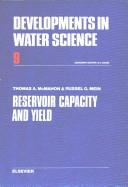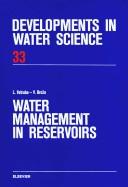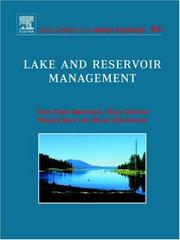| Listing 1 - 10 of 18 | << page >> |
Sort by
|
Book
ISBN: 0333246608 1349041335 9780333246603 Year: 1979 Publisher: Basingstoke Macmillan
Abstract | Keywords | Export | Availability | Bookmark
 Loading...
Loading...Choose an application
- Reference Manager
- EndNote
- RefWorks (Direct export to RefWorks)
Reservoirs --- 627.81 --- Artificial lakes --- Lakes, Artificial --- Lakes, Man-made --- Man-made lakes --- Tanks (Reservoirs) --- Bodies of water --- Hydraulic structures --- Reservoirs. Storage ponds --- 627.81 Reservoirs. Storage ponds

ISBN: 9780444416704 0444416706 9780080870007 0080870007 9786611772499 1281772496 Year: 1978 Publisher: Amsterdam ; New York : New York : Elsevier Scientific Pub. Co. ; distributors for the U.S. and Canada, Elsevier North-Holland,
Abstract | Keywords | Export | Availability | Bookmark
 Loading...
Loading...Choose an application
- Reference Manager
- EndNote
- RefWorks (Direct export to RefWorks)
Reservoir capacity and yield
Reservoirs. --- Water balance (Hydrology) --- Balance, Water (Hydrology) --- Artificial lakes --- Lakes, Artificial --- Lakes, Man-made --- Man-made lakes --- Tanks (Reservoirs) --- Bodies of water --- Hydraulic structures
Book
ISBN: 1283288184 9786613288189 0123855497 0123855489 9780123855480 Year: 2012 Publisher: Amsterdam : Gulf Professional Pub.,
Abstract | Keywords | Export | Availability | Bookmark
 Loading...
Loading...Choose an application
- Reference Manager
- EndNote
- RefWorks (Direct export to RefWorks)
Reservoir management is concerned with the geoscience and reservoir/production engineering required to plan and optimize the development of discovered or producing oil and gas assets. One of the only books to cover both management and engineering issues, Advanced Reservoir Management and Engineering is redesigned to be the only book you need throughout your career. Written by two of the industry's best-known and well respected reservoir engineers and managers, this new edition offers readers a complete guide for formulating workflow solutions on a day to day bases. Authoritative in
Oil reservoir engineering. --- Reservoirs --- Fluid mechanics. --- Management. --- Design and construction. --- Hydromechanics --- Continuum mechanics --- Artificial lakes --- Lakes, Artificial --- Lakes, Man-made --- Man-made lakes --- Tanks (Reservoirs) --- Bodies of water --- Hydraulic structures --- Petroleum engineering
Book
ISBN: 9811641978 981164196X 9811641994 Year: 2022 Publisher: Singapore : Springer,
Abstract | Keywords | Export | Availability | Bookmark
 Loading...
Loading...Choose an application
- Reference Manager
- EndNote
- RefWorks (Direct export to RefWorks)
Geology, Stratigraphic. --- Reservoirs. --- Artificial lakes --- Lakes, Artificial --- Lakes, Man-made --- Man-made lakes --- Tanks (Reservoirs) --- Bodies of water --- Hydraulic structures --- Age of rocks --- Rocks --- Stratigraphic geology --- Physical geology --- Age

ISBN: 0444989331 9786611777364 1281777366 0080870244 9780444989338 9780080870243 9781281777362 Year: 1989 Publisher: Amsterdam ; New York : New York, N.Y. : Elsevier ; Distribution for the U.S.A. and Canada, Elsevier Science Pub. Co.,
Abstract | Keywords | Export | Availability | Bookmark
 Loading...
Loading...Choose an application
- Reference Manager
- EndNote
- RefWorks (Direct export to RefWorks)
This book introduces methods for solving the technical and economic problems posed by water reservoirs, so as to ensure they have the best possible economic and social effect. The significance of reservoirs and the development of their function in water management is assessed, and they are classified according to origin and placing. Among the methods for solving the reservoir's function, both graphical and numerical procedures are described, based on the probability theory and mathematical statistics. In the explanation of the supply function of the reservoirs, attention is paid to the processing of hydrological data, the respective probability distribution is assessed, the theory of stochastic processes is explained, and methods of modelling the sequence of mean annual and monthly discharges are mentioned. The demands of consumers and the reliability of water supply are analysed. All types of reservoir discharge control are presented, i.e. multi-year, annual, short-term and compensation. A solution is given for the discharge control in reservoir systems and in special cases of water management, as well as in individual reservoirs. To describe the flood control function of reservoirs, hydrological data are evaluated, the precision of the flood regime characteristics is assessed, the flood routing in a reservoir is resolved, and the question of flood control is discussed. Control of a reservoir is ensured by a special space, as well as by utilizing the supply and overflow components of the reservoir. A separate part is devoted to the water management operations of reservoirs, mentioning the rules for control of the discharge from reservoirs in permanent operation, mainly using central control, and for the study and evaluation of the water management function of reservoirs. The last part of the book describes solutions for new reservoir functions resulting from their incorporation into water management systems and their function in the environment. The basic types of water management systems are described, as well as conditions for their optimal operation. In a similar way, the distribution of investment and operation costs for the various parts of a complex water management project are discussed in detail, as well as the economic impact of the reliability of water supply and flood control. The physical, chemical, biological and social consequences of reservoirs and their significance in creating a cultural landscape are analysed. The book is mainly intended for those who are involved in the development, preparation and operation of water management schemes and students of graduate and post-graduate courses in the field of water management.
Reservoirs. --- Water-supply engineering. --- Groundwater. --- Hydrology. --- Aquatic sciences --- Earth sciences --- Hydrography --- Water --- Ground water --- Subterranean water --- Underground water --- Water, Underground --- Hydrogeology --- Engineering, Water-supply --- Civil engineering --- Engineering --- Hydraulic engineering --- Artificial lakes --- Lakes, Artificial --- Lakes, Man-made --- Man-made lakes --- Tanks (Reservoirs) --- Bodies of water --- Hydraulic structures --- Purification
Book
ISBN: 012818003X 9780128180037 0128180021 9780128180020 Year: 2020 Publisher: Kidlington, Oxford, England ; Cambridge, Massachusetts : Butterworth-Heinemann,
Abstract | Keywords | Export | Availability | Bookmark
 Loading...
Loading...Choose an application
- Reference Manager
- EndNote
- RefWorks (Direct export to RefWorks)
Coastal reservoirs are viewed in many regions of the world as an emerging concept of storing fresh water when the river basin is in flood. Similar reservoirs (or impoundments) can be used to generate tidal renewable energy and/or provide the catalysis for urban regeneration. Constructed near the coast in natural river basins, these reservoirs have a smaller environmental footprint and are less obstructive than inland dams. Written by an international group of Civil, Environmental, and Geotechnical Engineers, Sustainable Water Resource Development using Coastal Reservoirs discusses the latest research and breakthroughs in their use, while offering expert advice into their sustainable design and construction. The perfect reference for researchers exploring the feasibility of this emerging technology or experienced professionals who wish to implement this technology as a water scarcity solution or a tidal renewable energy source or for urban regeneration, Sustainable Water Resource Development using Coastal Reservoirs provides an expert resource to the design, construction and use of coastal reservoirs. The reference begins with a brief but readable examination of water quantity, quality design and geotechnical considerations. The book includes international case studies to clearly illustrate the various uses, design, planning, construction, and operation methods. These case studies include projects such as: Afsluitdijk in the IJsselmeer, (Netherlands), Zuiderzee (Netherlands), Thanneermukkom Bund (India), Sihwa (South Korea), Saemangeum, (South Korea), Chenhang (China), Plover Cove (China), and Marina Barrage (Singapore).
Water resources development --- Water-supply. --- Coastal engineering. --- Reservoirs. --- Environmental aspects. --- Artificial lakes --- Lakes, Artificial --- Lakes, Man-made --- Man-made lakes --- Tanks (Reservoirs) --- Bodies of water --- Hydraulic structures --- Engineering --- Coastal zone management --- Shore protection --- Availability, Water --- Water availability --- Water resources --- Natural resources --- Public utilities --- Water utilities --- Environmental protection

ISBN: 9780444516787 0444516786 9780080535340 0080535348 9786611058012 1281058017 Year: 2005 Publisher: Amsterdam : Elsevier,
Abstract | Keywords | Export | Availability | Bookmark
 Loading...
Loading...Choose an application
- Reference Manager
- EndNote
- RefWorks (Direct export to RefWorks)
Lake and Reservoir Management
Water quality management. --- Reservoirs --- Lakes --- Lake restoration. --- Lake restoration --- Restoration ecology --- Eutrophication --- Lake reclamation --- Lake rehabilitation --- Lake renewal --- Reclamation of lakes --- Rehabilitation of lakes --- Renewal, Lake --- Restoration of lakes --- Bodies of water --- Lochs --- Ecosystem management --- Lake management --- Hydraulic structures --- Artificial lakes --- Lakes, Artificial --- Lakes, Man-made --- Man-made lakes --- Tanks (Reservoirs) --- Management --- Sewage disposal --- Water conservation --- Water-supply --- Water quality --- Water quality control --- Management.
Book
ISBN: 9781800738157 Year: 2023 Publisher: New York, NY : Berghahn Books, Incorporated,
Abstract | Keywords | Export | Availability | Bookmark
 Loading...
Loading...Choose an application
- Reference Manager
- EndNote
- RefWorks (Direct export to RefWorks)
Tap water enables the development of cities in locations with insufficient natural resources to support such populations. For the last 200 years, New York City has obtained water through a network of nineteen reservoirs and controlled lakes, some as far as 125-miles away. Engineering this water system required the demolition of rural communities, removal of cemeteries, and rerouting of roadways and waterways. The ruination is ongoing. This archaeological examination of the New York City watershed reveals the cultural costs of urban water systems. Urban water systems do more than reroute water from one place to another. At best, they redefine communities. At worst, they erase them.
Municipal water supply --- Urban watersheds --- Reservoirs --- Watershed management --- Urbanized watersheds --- Watersheds --- Cities and towns --- Urban water --- Water, Municipal --- Water, Urban --- Municipal engineering --- Water-supply --- Watershed development --- Ecosystem management --- Artificial lakes --- Lakes, Artificial --- Lakes, Man-made --- Man-made lakes --- Tanks (Reservoirs) --- Bodies of water --- Hydraulic structures --- History. --- Social aspects --- Management --- Archaeology, History (General), Political and Economic Anthropology.
Periodical
ISSN: 21515530 Year: 1984 Publisher: [Washington, D.C.] : [Philadelpha, PA] : [North American Lake Management Society], Taylor and Francis
Abstract | Keywords | Export | Availability | Bookmark
 Loading...
Loading...Choose an application
- Reference Manager
- EndNote
- RefWorks (Direct export to RefWorks)
Water quality management --- Lake restoration --- Lake restoration. --- Water quality management. --- North America. --- Water quality --- Water quality control --- Lake reclamation --- Lake rehabilitation --- Lake renewal --- Reclamation of lakes --- Rehabilitation of lakes --- Renewal, Lake --- Restoration of lakes --- Management --- Sewage disposal --- Water conservation --- Water-supply --- Lakes --- Restoration ecology --- Eutrophication --- Reservoirs --- Reservoirs. --- Artificial lakes --- Lakes, Artificial --- Lakes, Man-made --- Man-made lakes --- Tanks (Reservoirs) --- Bodies of water --- Hydraulic structures --- Turtle Island
Book
ISBN: 0875900178 Year: 1973 Publisher: Washington (D.C.): American geophysical union
Abstract | Keywords | Export | Availability | Bookmark
 Loading...
Loading...Choose an application
- Reference Manager
- EndNote
- RefWorks (Direct export to RefWorks)
556.55 --- 626.816 --- 574.5 --- Reservoirs --- -Artificial lakes --- Lakes, Artificial --- Lakes, Man-made --- Man-made lakes --- Tanks (Reservoirs) --- Bodies of water --- Hydraulic structures --- Limnology. Lakes. Reservoirs. Ponds --- Water extraction using wells, dams, drainage structures --- Hydrobiology. Aquatic biocoenoses and ecosystems. Food chains --- Congresses --- Congresses. --- -Limnology. Lakes. Reservoirs. Ponds --- 574.5 Hydrobiology. Aquatic biocoenoses and ecosystems. Food chains --- 626.816 Water extraction using wells, dams, drainage structures --- 556.55 Limnology. Lakes. Reservoirs. Ponds --- -574.5 Hydrobiology. Aquatic biocoenoses and ecosystems. Food chains --- Artificial lakes
| Listing 1 - 10 of 18 | << page >> |
Sort by
|

 Search
Search Feedback
Feedback About UniCat
About UniCat  Help
Help News
News